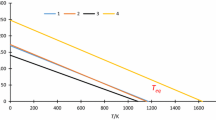Abstract
Following previous work on the measurement of meaningful activation energies and the application of Constant Rate Thermal Analysis (CRTA) to the determination of kinetic parameters [1, 2], here we further examine sources of error in determining activation energies and go on to consider the form of the alpha function and the value ofA. Using theoretical arguments based on transition state theory, we conclude that allowing significant pressures of product gas to appear in the reaction environment will lead to very high values for apparent activation energies. We note that, although this is observed in practice for calcium carbonate, it in no way invalidates the application of the Arrhenius equation to solid state decomposition reactions, provided care is taken to avoid this type of distortion of experimental results. We attempt to determine the alpha function for the decomposition of calcium carbonate using data gathered from a variety of different types of temperature programme and reaction conditions. We find that the apparent alpha function depends on the method adopted and the experimental conditions used. We propose an explanation of why this occurs and tentatively introduce a new way of looking at the development of a reaction interface for this type of reaction. We review the literature and conclude that, while significant variations for the activation energy for the decomposition of calcium carbonate exist, a critical appraisal leads to good agreement amongst values that follow good experimental practice and reliable methods of data reduction. The apparent divergence of results can be explained in the light of the theoretical arguments advanced and the easily understood sources of experimental error.
Zusammenfassung
Im Anschlu\ an vorangehende Arbeiten zur Messung sinnvoller Aktivierungsenergien und zur Anwendung von CRTA bei der Bestimmung kinetischer Parameter untersuchen wir hier weitere Fehlerquellen bei der Bestimmung der Aktivierungsenergien und stellen überlegungen zur Form der Alpha-Funktion bzw. zum Wert von A an. Ausgehend von theoretischen Argumenten, die auf der Theorie des übergangszustandes basieren, schlossen wir darauf, da\ es unter Berücksichtigung bedeutender Drücke der in der Reaktionsumgebung auftretenden gasförmigen Produkte zu sehr hohen Werten für die scheinbaren Aktivierungsenergien kommt. Es sei bemerkt, da\, obwohl dies in der Praxis für Calciumkarbonat beobachtet werden kann, es in keiner Weise die Anwendung der Arrheniusschen Gleichung bei Feststoff-Zersetzungsreaktionen in Frage stellt, vorausgesetzt, man vermeidet diese Art von Beeinflussung der Versuchsergebnisse. Für die Zersetzung von Calciumkarbonat versuchten wir, die Alpha-Funktion unter Anwendung von Daten zu bestimmen, die einer Reihe verschiedener Temperaturprogramme und Reaktionsbedingungen entstammen. Man fand, da\ die scheinbare Alpha-Funktion von der angewendeten Methode und den Versuchsbedingungen abhÄngt. Es wird eine ErklÄrung dafür vorgeschlagen und vorlÄufig eine neue Betrachtungsweise für derartige Reaktionen eingeführt. Bei einer Durchsicht der Literatur konnte darauf geschlossen werden, da\ zwar sehr viele Varianten für die Aktivierungsenergie von Calciumkarbonat existieren, da\ aber eine kritische EinschÄtzung zu einer guten übereinstimmung derjenigen Werte führt, denen gute Versuchspraktiken und eine zuverlÄssige Datenverdichtung zugrunde liegen. Die scheinbaren Unterschiede der Ergebnisse können unter Berücksichtigung der vorgebrachten theoretischen Argumente und leicht verstÄndlicher experimenteller Fehlerquellen erklÄrt werden.
Similar content being viewed by others
References
M. Reading, D. Dollimore, J. Rouquerol and F. Rouquerol, J. Thermal Anal., 29 (1984) 775.
M. Reading, Thermochim. Acta, 135 (1988) 37.
D. Dollimore, W. E. Brown and A. K. Galwey, Comprehensive Chemical Kinetics. Vol. 22, C. H. Bamford and C. F. Tipper (ed.), Elsevier, Amsterdam, 1980.
P. Barret, C. R Acad. Sci., Ser. C, 266, 856 (1968).
W. Searcy and D. Beruto, J. Phys. Chem. 82 (1978) 163.
D. Beruto, L. Barco, A. Searcy and G. Spinolo, J. Am. Ceram. Soc., 63 [7–8] (1980) 43.
J. Zawadshi and S. Bretsznujder, Trans. Faraday Soc., 34 (1938) 951.
E. Cremer and E. Nitsch, Z. Electrochem. 66 (1962) 697.
T. R. Ingraham and P. Marier, Can. J. Chem. Eng., 41 (1963) 170.
C. R C. Handbook of Chemistry and Physics, Ed. R C. Weast, 59th edition, CRC Press Inc., (1978) F90.
H. T. S. Britton, S. J. Gregg and G. W. Windsor, Trans. Faraday Soc., 48 (1952) 63.
M. E. Brown and A. K. Galwey, Thermochim. Acta, 29 (1979) 507.
P. D. Garn, J. Thermal Anal., 13 (1978) 581.
R. A. W. Haul and L. H. Stein, Trans. Faraday Soc., 51 (1955) 1280.
J. H. Sharp, G. W. Brindley and B. N. N. Achar, J. Am. Ceram. Soc., 49 (1966) 379.
R. Whitehead, D. Dollimore, D. Price and N. S. Fatemi, in Proc. 2nd Eurp. Symp. on Thermal Analysis, D. Dollimore (ed.), Heyden, London, 1981, p. 51.
P. K. Gallagher and D. W. Johnson, Thermochim. Acta, 6 (1973) 67.
K. M. Caldwell, P. K. Gallagher and D. W. Johnson, Thermochim. Acta, 18 (1977) 15.
D. Beruto and A. W. Searcy, J. Chem. Soc. Faraday Trans. 1., 70 (12) (1974) 2145.
G. Guler, D. Dollimore and G. R. Heal, Thermochim. Acta, 54 (1982) 187.
F. Rouquerol and J. Rouquerol, Proc. 3rd ICTA, Vol. 1, H. G. Wiedermann (ed.), BirkhÄuser, Basel-Stuttgart, 1972, p. 373.
P. K. Gallagher and D. W. Johnson, Thermochim. Acta, 14 (1976) 255.
D. M. Speros and R L. Woodhouse, J. Phys. Chem., 72 (1968) 2846.
J. H. Sharp and S. A. Wentworth, Anal. Chem., 41 (1969) 2060.
E. S. Freeman and B. Caroll, J. Phys. Chem., 62 (1958) 394.
A. W. Coats and J. P. Redfern, Nature, 201 (1964) 68.
T. R. Ingraham and P. Marier, Can. J. Chem., 62 (1958) 394.
W. Maskill and W. E. S. Turner, J. Soc. Glass Technol., 16 (1932) 80.
A. L. Draper and L. K. Sveum, Thermochim. Acta, 27 (1962) 68.
Author information
Authors and Affiliations
Additional information
One of the authors (M. Reading) would like to thank the French goverment for a scholarship that enabled him to carry out part of the work in France and J. Rouquerol and F. Rouquerol for allowing him to use their specialised thermobalance.
Rights and permissions
About this article
Cite this article
Reading, M., Dollimore, D. & Whitehead, R. The measurement of meaningful kinetic parameters for solid state decomposition reactions. Journal of Thermal Analysis 37, 2165–2188 (1991). https://doi.org/10.1007/BF01905585
Issue Date:
DOI: https://doi.org/10.1007/BF01905585



